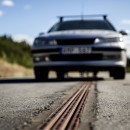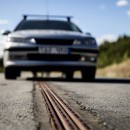As most companies orcountries that have a say in the automotive industry are racing to develop electric cars and related systems, very few are actually worrying on how to make adoption of such technologies both easier and faster.
The main problem with electric vehicles is still, nearly ten years since the introduction of the mass produced Nissan Leaf, charging. At a glance, it seems electric cars are coming for us faster than we can develop and expand a comprehensive charging network.
The main reasons behind the difficulty in creating such a network are money and space. It’s very difficult to find room for charging stations, to install them in accessible locations and to protect them from damage. And it also cost money.
This is why there are some who are looking into taking advantage of the existing road network to provide charging for electric vehicles. And one such project takes place in Sweden, under the eRoadArlanda project.
Sweden, as one of the leading nations when it comes to embracing environmentally-friendly ideas, plans that by 2030 to have a fossil fuel-free transportation infrastructure. According to local studies, road traffic is responsible for 33 percent of carbon emissions in the European country.
The adoption of an electrified network of roads, especially for freight traffic, might lead, say the Swedes, to a 80-90 percent reduction in emissions.
The conglomerate plans to electrify only 2 to 4 percent of the road network, meaning the major routes in the country. The rest of the roads, eRoadArlanda says, could be travelled on battery power.
But there is also another electric concept, namely continuous supply of power. It is a concept seen in action in public transport systems: trolleybuses, subway trains, trams and so on.
eRoadArlanda’s goal is to combine these two worlds: provide continuous power to EVs on certain roads, so that they can maintain battery levels to use on the rest of the network.
The arm of the vehicle knows were the rails is in the road and when the car is in position it lowers to make contact. It can be raised when it detects the driver is about to overtake other vehicles.
The rail is divided into sections that only activate when a vehicle is directly overhead, as to save the energy in the grid. It can also sense when a car stops, so as to discontinue the current.
This system allows cars to drive on direct power, while also charging the battery for future use.
Conductive electrification works on all types of cars, from trucks carrying cargo to small passenger cars. Public transport could also take advantage by clearing the skies in cities where trolleybuses take their electricity from overhead wires.
Getting rid of overhead wires would also improve the look of the city, not to mention the field of vision for those in traffic.
The biggest problem with such a system is the fact that additional hardware needs to be added to the car.
Since the service will not be free, additional software would have to be included, so that the rail knows who is using it and bill the electricity properly.
The main reasons behind the difficulty in creating such a network are money and space. It’s very difficult to find room for charging stations, to install them in accessible locations and to protect them from damage. And it also cost money.
This is why there are some who are looking into taking advantage of the existing road network to provide charging for electric vehicles. And one such project takes place in Sweden, under the eRoadArlanda project.
WHAT IS IT?
eRoadArlanda is a conglomerate of companies and institutions looking to create a network of electrified roads based on conductive technology.Sweden, as one of the leading nations when it comes to embracing environmentally-friendly ideas, plans that by 2030 to have a fossil fuel-free transportation infrastructure. According to local studies, road traffic is responsible for 33 percent of carbon emissions in the European country.
The adoption of an electrified network of roads, especially for freight traffic, might lead, say the Swedes, to a 80-90 percent reduction in emissions.
The conglomerate plans to electrify only 2 to 4 percent of the road network, meaning the major routes in the country. The rest of the roads, eRoadArlanda says, could be travelled on battery power.
THE BEST OF TWO WORLDS
An electric vehicle is capable of operating thanks to electricity. This can come from a storage unit, the battery pack, or can be supplied continuously, via a wire, cable or some other means. All electric vehicles currently on the market are battery-powered, meaning they need to charge from time to time.eRoadArlanda’s goal is to combine these two worlds: provide continuous power to EVs on certain roads, so that they can maintain battery levels to use on the rest of the network.
HOW IT WORKS
That means fitting roads with a metal track that runs its length. The track consists of a metal rail, connected to the public power grid, that can detect when a vehicle moves in position. To be able to take power from the rail, a special contact arm must be attached to the bottom of the vehicle.The arm of the vehicle knows were the rails is in the road and when the car is in position it lowers to make contact. It can be raised when it detects the driver is about to overtake other vehicles.
The rail is divided into sections that only activate when a vehicle is directly overhead, as to save the energy in the grid. It can also sense when a car stops, so as to discontinue the current.
This system allows cars to drive on direct power, while also charging the battery for future use.
ADVANTAGES & DISADVANTAGES
Implementing such a system can be done with a minimum investment. The rails can be embedded into the existing road networks, making the need for additional construction project pointless.Conductive electrification works on all types of cars, from trucks carrying cargo to small passenger cars. Public transport could also take advantage by clearing the skies in cities where trolleybuses take their electricity from overhead wires.
Getting rid of overhead wires would also improve the look of the city, not to mention the field of vision for those in traffic.
The biggest problem with such a system is the fact that additional hardware needs to be added to the car.
Since the service will not be free, additional software would have to be included, so that the rail knows who is using it and bill the electricity properly.






